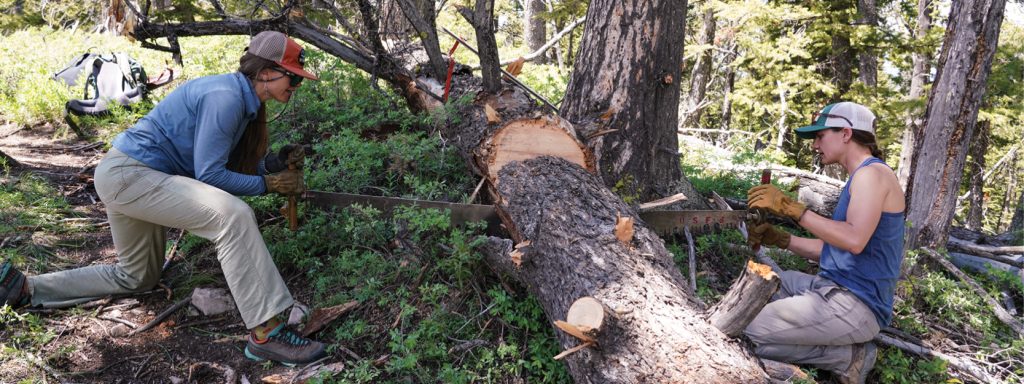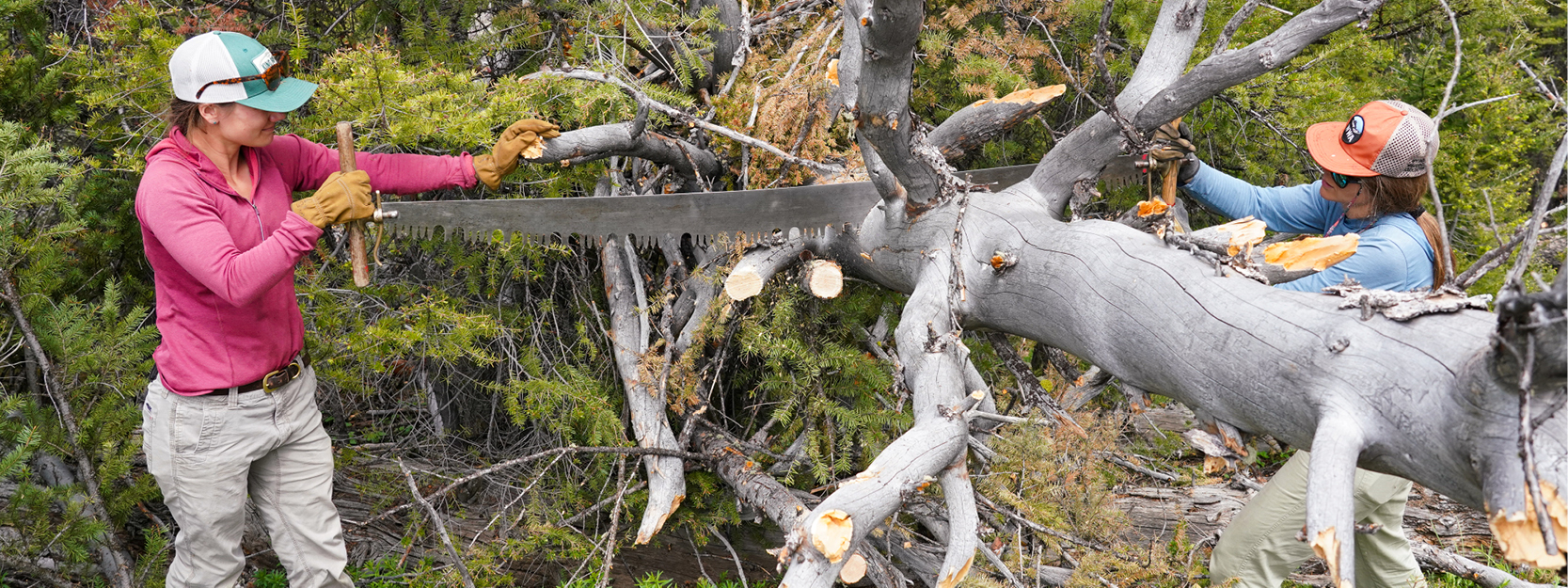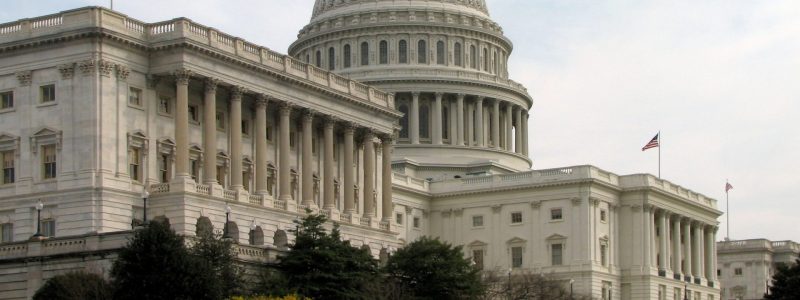Federal employees are the heartbeat of public lands stewardship.
What happens when they’re gone?
A giant downed tree and wreckage of limbs block the trail. Peggie dePasquale considers the obstacle in thoughtful silence, calculating the angles. Finally she nods. “If we cut here, and get a little lucky, we may be able to roll it off the trail — no need for a second cut.” She pauses to wipe the sweat from her forehead. “But we definitely need to get a little lucky.”
My colleague Gabby Yates and I have joined Peggie here in Wyoming’s Gros Ventre Range — an amorphous group of mountains in designated wilderness between the Continental Divide and the Tetons — to see firsthand what’s happening to public lands as the Trump administration culls the federal workforce. For much of the morning we’ve been inching up a forested ridgeline, stopping frequently to clear deadfall.
Gabby lops off limbs with the Pulaski, a modified axe, while Peggie and I sever branches with handsaws. Then it’s time for the giant log, and the crosscut saw. The tinny rasp of the five-foot saw, commonly used in wilderness areas where mechanized equipment isn’t allowed, rings through the forest. Fifteen minutes of steady, sweaty back-and-forth later, the log finally splits and crashes to the ground.
Until recently, Peggie roamed this area as a wilderness ranger for the Bridger-Teton National Forest, where she not only did trail upkeep but also collected vital data and educated visitors. But in February, she was terminated from her position, joining thousands of other federal employees suddenly out of work. Now, months later, the cost of having fewer people to steward public lands — people who maintain campgrounds and trails, protect wildlife habitat and cultural resources, manage wildfire risk, and respond to emergencies — is becoming clearer and clearer.

Peggie had worked in and around the Bridger-Teton National Forest for more than a decade, first as a field instructor for the Teton Science School and later as an organizer for the Wyoming Wilderness Association. But she was relatively new to the Forest Service, with just two field seasons as a ranger under her belt.
In late January of this year, while spending the off-season in France for her husband’s job, Peggie received the infamous “Fork in the Road” email pressuring federal employees to resign. She had been looking forward to the upcoming season in the Gros Ventre: Her work plan was finalized, and a promotion to crew lead was on the horizon. Leaving her post was the last thing she wanted. She ignored the email.
But on Valentine’s Day, while skiing with friends, she received a text: The district ranger needed to speak with her immediately.
“I found a way to give them a call and received the news that the leadership at the Jackson district of the Bridger-Teton Forest were instructed as of that morning to terminate all probationary staff based on performance,” Peggie tells us. “Leadership had been given a day to make these calls to people who they wanted, more than anything, to keep on their team. Their hand was forced.” The call was followed up with a letter that said that she had not performed up to par and that’s why they were letting her go, despite her excellent performance reviews.
Peggie was among at least 2,400 Forest Service employees with probationary status (which includes new hires and recently transferred or promoted employees) who were fired that weekend. In the weeks and months that followed, chaos within federal agencies reigned, with further mass layoffs and the shuttering of dozens of federal offices. As of June, in the Forest Service alone, the number of employees fired or who took the government’s “deferred resignation,” a buyout designed to downsize the federal workforce, totaled 7,500 — more than 20 percent of the Forest Service’s workforce.
A month after Peggie was fired, a federal judge ruled some of the layoffs unlawful, and Peggie was told she could return to her post. But by that point, she had already accepted another job offer.
She faced a dilemma: Should she stick with the new position, or return to the job she’d been heartbroken to lose? And if she did return, would she lose the job again just as easily? As one current Bridger-Teton National Forest employee (who asked to remain anonymous for fear of retaliation) described, the atmosphere within the agency for those who remain has been turbulent, in large part due to ever-shifting directives. “Sometimes it seems purposefully chaotic, but I think a fair amount of it is sheer ineptitude,” they said. “In the meantime, agency personnel are getting ping-ponged back and forth with no context, no clarity, and no real actionable direction.”
Ultimately, Peggie decided not to return to the Forest Service, opting instead to stay in the role she’d just accepted: National Forest Wildlands Director for the Wyoming Wilderness Association, her previous employer.
We traverse flower-filled meadows bordered by red rock outcroppings and hike higher into the mountains. Peggie literally wears a different hat now — an orange cap emblazoned with WWA’s logo — and the trail work we’re doing with her today is not part of her typical job duties. But she’s the kind of person who can’t visit the forest without pitching in: When Gabby and I asked her to show us around, there was never any question that we’d load up the saws.
As we hike, Peggie points out examples of the work she and her former colleagues did here in past years. Some, like the sturdy bridges that span creeks and streams, are obvious displays of labor. Others, like the drainage ditches dug to mitigate rutted trails, are less obvious. Peggie shares that because of staffing cuts, it’s unlikely that a Forest Service crew will make it to this trail this year — meaning the hard work that keeps trails accessible and safe just won’t happen.
Because of staffing cuts, it’s unlikely that a Forest Service crew will make it to this trail this year —
— Peggie dePasquale
meaning the hard work that keeps trails accessible and safe just won’t happen.
Rutted trails and deadfall may seem like a minor inconvenience for many visitors. But for others, like horsepacking outfitters, the impacts can be far greater. “There are people that rely on these trails for their livelihood, and who don’t necessarily have the capacity in the pre-season to spend whole days clearing trail,” my colleague Gabby, who has a background leading horsepacking trips, explains. And with fewer Forest Service staff, the backlog of trails that need clearing will continue to grow.
The impacts of staffing cuts don’t stop with unmaintained trails. Fewer backcountry crews means less data on wilderness visitorship, which forest managers use to make sound management decisions. Cuts have also halted studies of invasive weeds, which Peggie says represent one of the most pressing threats to the Gros Ventre. “At the end of last year, we were working with our GIS specialists to create a survey that would allow us to track infestations,” she shares. From there, managers would work with an invasive species specialist to find a solution. “But now, a program that had so much potential and energy and enthusiasm is just no longer.”
Then of course there’s wildfire: Wilderness crews, like the crew Peggie was on, reduce fire risk by educating visitors about campfire safety, ensuring campfires are properly extinguished, and reporting newly started blazes in the backcountry. Other Forest Service employees play vital roles, too. Without adequate staff for fuels mitigation or trail maintenance, catastrophic burns are more likely, and firefighting personnel may struggle to get where they need to go. Without administrative staff, fire crews face travel delays. And with fewer support staff trained to aid in fires — red card carriers — crews on the frontlines carry a heavier burden.
The Bridger-Teton National Forest, though it encompasses an enormous 3.4 million acres, represents only a fraction of the 30 million acres of federally managed public lands in Wyoming — nearly half the state. I ask Gabby, who is in charge of the public lands program at the Wyoming Outdoor Council, how the impacts from layoffs that we’re seeing here fit into the larger picture of public lands across the state and the West.
She says she’s less worried about unmaintained trails or bathrooms and more concerned with, “What’s going to happen to these ecosystems? We’re talking about wildlife resources. We’re talking about watershed resources. If there’s no one there to manage these issues, the problems we have are just going to be exacerbated.”
Indiscriminate firings of land stewards are a devious part of a much larger effort to transfer public lands to state control, Gabby continues. “With these layoffs, there’s a slippery slope: If we’re not properly staffing these places, we’re not properly managing them, and when that occurs, they become more of a liability than an asset, and there’s more of an excuse to sell them off.”
Although the push for public lands transfer has a long history, it was brought into sharp focus this summer, when Congress tried to include the sale of millions of acres in the federal budget reconciliation bill. If there’s anything to learn from the past, it’s that transfer of public lands to states is a direct pathway to sale and privatization, as states eventually realize they have nowhere near the resources needed to manage lands, let alone turn a profit.
If there’s anything else to be learned, it’s how fervently Americans want to see their public lands protected, not sold off. With the recent sell-off attempts in Congress, for example, the backlash was swift and enormous, and showed just how disconnected many politicians are from the lands they seek to sell off. “Decision makers aren’t seeing places that people care about, or rely on for clean water, or cultural values, or recreation,” Gabby says. “They’re seeing something that you can extract value from.”
Places like the Gros Ventre are ground zero for such attempts: It’s Forest Service land that doesn’t have the recognition of, say, a national park, and therefore means little to distant politicians. Yet for those nearby — people like Peggie, Gabby, and countless others — such places are more than just land. They’re cherished parts of their backyards, places whose true value defies measurement.

We clear tree after tree as the heat of the afternoon builds. Peggie patiently explains to Gabby how to avoid getting the crosscut saw stuck; she hands me the axe and tells me to enjoy some “wilderness therapy.” The work feels good, and the results are immediately tangible — one of the things Peggie loved most about this work.
On a small scale, there’s no doubt we’re making a difference. And we’re not the only ones, either: From individuals to organizations, there’s no shortage of people stepping up to fill the gaps left over from staffing cuts. The Friends of the Bridger-Teton, for example, recently launched the FBT Forest Corps, an initiative that lends a hand on vital trail infrastructure projects. WWA, Peggie’s organization, helps fund this new initiative, and also regularly trains volunteers to conduct solitude monitoring surveys that would otherwise go undone.
On the other hand, Peggie is clear that our work today is but a drop in the bucket. Nothing, she says, can replace the work done by a full wilderness crew.
“… Our work today is but a drop in the bucket. Nothing can replace
— Peggie dePasquale
the work done by a full wilderness crew.“
We stay past our agreed-upon turnaround time to clear one last log. Finally, though, we turn our backs on whatever awaits up the trail and begin the hike down.
Our talk turns to what gives us hope, for the Gros Ventre and places like it. “For me, it’s the community of people who care for wild places,” Peggie says. “Which is interesting — this idea that it’s people who are bringing us to this point of conflict, and it’s also people who give us hope that we’re capable of finding a solution.”
As we pass the wooden sign marking the wilderness boundary, Peggie gives it a pat like it’s an old friend. With it, she seems to say goodbye. And — I’ll be back.
Have you noticed impacts on public lands from federal layoffs?
Let us know! Fill out our form at our Federal Layoff Hotline below.



